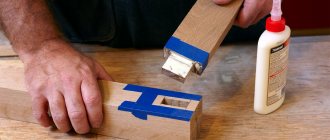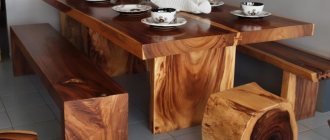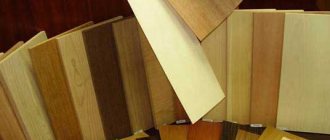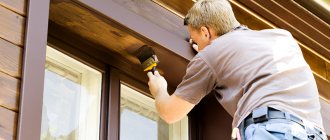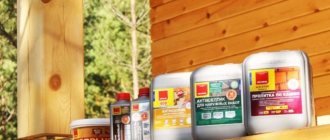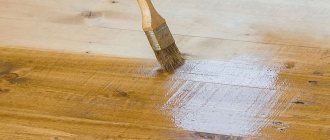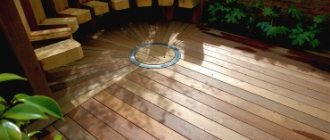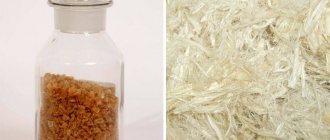Gluing wood has to be done not only by carpenters, but often by ordinary people as well. To obtain a reliable and durable connection, it is important to choose the right glue for wood. Let's take a closer look at what adhesive compositions are, which brands are the best, what they are used for, and how to choose the best option for a particular situation.
Properly selected adhesive provides a “reinforced concrete” connection for any wooden surface Source i.ytimg.com
Classification of adhesives
Wood adhesives have different compositions and areas of application. Some of them are recommended as universal products, and gluing wooden surfaces is only one of the purposes. Other compounds have a narrow purpose and are applicable only under certain conditions. To quickly navigate the vast assortment of adhesive compositions, you need to know by what principle they are classified.
By composition
The first thing you need to pay attention to is the composition of the glue, which is as follows:
- Bone. It is obtained by extracting an adhesive substance from the bone remains of animals. Transparent is the best glue for wood in comparison with colored glue, as it is free of impurities. Has an average price category.
- Hide glue is obtained by processing the skin of animals. It comes in different forms – powdery, tile, scaly.
- Fishy. It is made from the remains of fins and scales. Refers to professional compositions. Suitable for gluing surfaces with different levels of rigidity. Mainly used in the repair of expensive furniture made of valuable wood.
Fish glue for wood - effective and inexpensive Source www.kraski-kisti.ru
- Casein glue requires preliminary preparation, which requires strict adherence to the instructions. Otherwise, the resulting glue will not have the required level of quality. It is characterized by moisture resistance and the creation of a connection with increased strength. Used in aircraft modeling and shipbuilding.
- Polyurethane wood glue is one of the most expensive products. Has a number of positive characteristics. It is recommended for use in cases where the connection will be subject to dynamic loads, used at critical temperatures, in a humid environment and in direct sunlight.
Polyurethane glue is the most popular among both professional carpenters and garage workers. The high quality of the resulting compound fully justifies the cost of the product.
By purpose
By type, adhesive compositions are classified into several large groups: universal and highly targeted.
Universal adhesives include such adhesives as:
- BF has several episodes. For working with wood, the 2nd and 4th are applicable. Characterized by fast setting - up to 60 minutes.
BF glue for home use Source onepriceshop.ru
- PVA is the most common type of glue. It is often used by professional carpenters. It is characterized by rapid setting, non-toxic, can withstand static loads of up to 60 kg/cm2, and is suitable for all types of wood. Reduced adhesion quality in rooms with high humidity. To avoid this, it is recommended to add wood dust.
- Epoxy glue is a two-component composition that must be diluted before use in accordance with the instructions. If the proportions are calculated incorrectly, the adhesive composition will be ineffective. Toxic during use. You need to work with it strictly in a protective suit and in a well-ventilated area.
It is believed that epoxy wood glue is the most durable. It is also resistant to aggressive environments and water.
Specialized ones include:
- Wood glue. The basis is organic protein. Applicable only to wood and items made from wood fibers. Before use, it must be diluted in a certain proportion. Non-toxic and safe for health.
Variety of carpentry adhesives Source woodpro.by
- Heat-resistant rods. Indispensable for gluing small parts and repairing minor defects. The effect is immediate.
Specialized compounds are used in the production of furniture, doors, windows, stairs and other structures. With their help, you can also carry out short-term household repairs of wooden elements.
Homemade compositions
You can not only buy wood glue, but also make it yourself:
- Paste. Used for priming and filling wood. A mixture of wood glue, ash and chalk is prepared. Each master has his own ratio of components, verified experimentally. As a rule, the components are taken in proportions 2: 1: 0.5.
- Moisture-resistant composition. It is prepared from slaked lime and freshly curdled cottage cheese. The components are mixed and heated in a water bath. The resulting glue is applied along the fibers. If the wood has a moisture content of more than 10%, the effectiveness of gluing is reduced.
- Syndeticone glue is a mixture of wood glue, lime and powdered sugar. It takes a long time to prepare the composition - the components must be soaked in advance for at least 24 hours. But, such glue is resistant to moisture, various chemicals and increased strength.
The process of preparing synditecone glue Source i0.wp.com
Homemade compositions give good quality joints only if all stages of preparation are followed with precision. Otherwise, the resulting “porridge” is useless.
The best resin-based adhesives for wood
Fortis EDP
Transparent epoxy adhesive is a universal means for gluing wood to surfaces made of various materials that differ in structure. The Fortis EAF product consists of a modified epoxy resin + a special hardener.
Pros:
- Small price.
- Convenient packaging and packaging in tubes.
- Versatility (wood + metal, porcelain, glass, stone, ceramics, tiles, etc.).
- High quality, reliable adhesive seam.
- Wide range of applications (repair of decorative elements, plumbing fixtures, cabinet parts of household appliances, acrylic bathtubs, sports equipment, etc.)
Minuses:
- There are no disadvantages.
Super Epoxy Moment
Unlike other analogues, Moment Super Epoxy disposable adhesive is much more convenient to use. It's all in the packaging. Here the hardener and resin are located in separate plastic syringes. The components are squeezed out and mixed in a small container using a small spatula, a wooden stick, or a flat piece of wood. Scope of use: reliable quick gluing of parts made of wood, porcelain, metal, plastics, etc. in various combinations.
Pros:
- High efficiency.
- Versatility.
- No need to think about proportions.
- Small package, you can carry it in your purse just in case.
- A small amount of the composition is enough to glue small parts in several places.
- Resistant to moisture, aggressive media (solvents, oils).
- Can be used in a wide temperature range from minus 30 to plus 150 degrees C.
Minuses:
- Apart from the unpleasant odor, there are no drawbacks.
What glue is used where?
Today, a universal glue for wood has not yet been developed - which one is better must be chosen based on the tasks, and the material used, we will consider in more detail using the example of popular brands.
For sexual work
For working with plywood and installing floors, the best adhesives are:
- Chemolan B45 is a universal wood adhesive that is waterproof and therefore indispensable for flooring work, since the resulting joint has increased strength, ductility, and does not deform when heated and hardened.
- Bostik Tarbicol PU 1K is intended for installation of parquet and solid wood boards on various surfaces. Allows you to smooth out small irregularities, a good level of frost resistance and insensitivity to heating. Easy to apply. Instant grip. Releases toxins when working with it. Contact with skin and mucous membranes is not allowed.
Bostik Tarbicol PU 1K - good but caustic glue Source mirom.by
- Ceresit R 710 is a universal adhesive for interior and exterior use. Suitable for all surfaces. Recommended for gluing wooden floor slabs, especially if they are located in production workshops.
- Chimiver Adesiver Elastic is intended for parquet work. In addition to the fact that this wood glue is waterproof, the joints have increased elasticity and strength. Hardening occurs within three days.
- Titebond from Franklin International . It contains no solvents. The basis is synthetic and natural polymers. Suitable for working with any wooden surfaces and other materials.
See also: Catalog of companies that specialize in finishing materials and glass products.
For windows, doors and stairs
The manufacture of stairs, windows and doors requires a particularly strong connection of all components. The seams must be monolithic. The best adhesive compositions for these purposes are:
- Rakoll is a German quality glue. The seams are heat and water resistant. Fast setting. Suitable for cold and hot gluing. Has deep penetration. Upon contact with metal, a blue tint appears.
Reliable glue, but it is better not to use it for metal connections Source im9.cz
- Kiilto to PVA D3 is a PVA glue for wood with increased frost resistance and water-repellent properties.
- Ultima Joiner PVA is universal. Suitable for working with any type of wood. It has high connection strength - 0.9 kgf/cm. Therefore, it is recommended when gluing steps and other parts of stairs. Suitable for street work. The downside is that it takes a long time to dry.
- Titebond original wood glue is one of the best professional glues. Well connects surfaces with a large area. Particularly strong groove and tenon joints are obtained. Has high consumption.
- Titebond III Ulimate 1416 is a professional composition. Meets all ANSI/HPVA Type I standards. This indicates that the resulting connection has an increased level of water resistance. The first and only adhesive that can be cleaned with water. Characterized by strong initial adhesion of the joint. Can be used for outdoor work. Non-toxic. The seam can be sanded.
Some tips for proper use
When using, you must take into account the advice of the experts:
- Wooden parts for gluing should not have a moisture content of more than 12 percent (sometimes up to 18).
- For wood with high humidity, polyurethane adhesives are used, which are able to draw moisture out of the wood.
- The outside air temperature during the gluing process must be at least 18 degrees, then high-quality gluing will occur.
- Excess glue, before polymerization, is removed with a damp cloth or rag.
We recommend watching the video review:
Video description
What EDP epoxy glue is is described in more detail in the video:
- SOUDAL 66A products deserve special attention . It is universal and suitable for absolutely any surface. Indispensable in the manufacture of garden furniture and facade work. But you need to know how to work with it, as it expands when it dries.
- Kleiberit 303 .0 is suitable for working with any wood (even the densest) and with all types of wood-containing materials. Characterized by quick setting and reliable seam.
- Glue such as Moment Joiner has an expanded scope of application. Characterized by a particularly strong connection of surfaces. It takes on the color of wood, so we recommend it for working with light varieties. The glue does not contain toxic substances and is environmentally friendly. Characterized by fast setting, resistance to moisture and critical temperatures. With all this, it has a relatively low cost.
Moment Joiner is available in different packaging Source www.bel-plast.com
Artelit WB-330 glue has similar characteristics . But, it has an assigned water resistance class - D300. Not flammable. Upon contact with open fire and under the influence of critical temperatures, they will not release toxic substances.
How to use it correctly
The rules for using any type of adhesive imply the fulfillment of individual requirements that affect the scope of application. But, there are general principles that you need to rely on when working with any wood glue:
- Mandatory cleaning of surfaces not only from dirt, but also from paint and varnish coatings. You can go over the surface with any degreasing solution and let it dry.
- Preliminary assembly of all parts to be glued “dry”.
- Not all elements can fit tightly together, which is necessary to obtain a reliable connection. To ensure this, all surfaces to be glued must be tightened with a clamp until the composition dries completely. Usually it comes within a day. But there are also quick-setting adhesives. It all depends on the type of composition and its manufacturer.
Nuances of choosing glue
When buying wood glue, in addition to basic information about the composition and manufacturer, you need to take into account important nuances:
- For light wood species, the choice of casein glue is extremely unfortunate, since it darkens over time. It is better to opt for Joiner, which takes on the shade of the wood being glued together.
- If you plan to disassemble glued parts in the future, it is better to give preference to casein or bone glue. For long-lasting connections, synthetic compounds are more suitable.
- The quality of PVA glue can be determined by eye. If its consistency is too thick (the composition is very viscous) or liquid (increased fluidity), then the quality leaves much to be desired. Most likely, the rules for transporting and storing the product were violated.
- Features of wood. Not all compounds are suitable for working with resinous and wet surfaces.
When sizing a large volume of wood, in order to save money, it is best to give preference to powder formulations. Unless the quality of the connection suffers from this choice.
DIY laminated wood
Before gluing, the parts are processed; this is done not only to clean the surface, but also to open the wood pores. When applied, the adhesive composition penetrates through the pores into the wood structure, into the intercellular space, and when hardened, it forms many thin threads (webs) that reliably “stitch” the workpieces together. The strength of a correctly executed seam exceeds the strength of the wood itself; when testing for fracture, the part breaks not at the gluing site, but along the whole wood.
Gluing wood allows you to obtain products with better parameters than solid ones. During the gluing process, elements that are suitable in texture and shade are selected, damaged, cracked and knotty areas are rejected. As a result, the glued parts have greater strength than ordinary wood, and by gluing the finest veneer onto the front surfaces, the products are given the appearance of the most valuable species. Wood glued according to all the rules is much less likely to warp, crack and dry out than solid wood.
Briefly about the main thing
Wood glue has a wide range, divided into subtypes depending on the composition and purpose. If you wish, you can even independently make a composition suitable for its properties.
Wood glue is available in a wide range. We looked at the best products from different manufacturers. As we found out, a certain brand of glue can be used for many works, but it is recommended for use for certain types of work.
But the ideal wood glue has not been developed - which is better in a particular situation depends on the purpose and type of material. When choosing glue, you should also rely on certain subtleties regarding certain brands of glue.
It is worth remembering that purchasing expensive wood glue does not guarantee a reliable connection if the work was carried out poorly. It is important to carry out all the work gradually and not skip anything. Otherwise, there is a risk of gluing defects.
Advantages and disadvantages of each option:
- Strength: plus on the side of spliced panels.
Many sources claim that spliced gluing is stronger than solid lamella. After all, the slats are fixed using a special technology. More glue is used. Smaller blocks are used, which makes the entire structure more stable compared to one made from long slats.
However, this is not quite true! Most woodworkers are confident that the type of gluing does not in any way affect the reliability and density of the furniture board or step. The only thing it changes is the appearance of the final product!
Spliced gluing is indeed very strong, but solid lamella is not inferior. Both mounting options provide sufficient stability to the final product and long service life.
- Appearance, attractiveness: a plus on the side of solid-lamella panels.
Indeed, products made using solid-lamella gluing look much more attractive than those made using spliced panels.
In some cases, it is possible to hide this defect by tinting or painting.
True, for some, the fragmentation of texture is not a disadvantage. After all, this is how expensive and high-quality parquet has been laid since ancient times. That’s why this type of gluing is sometimes called “parquet”. Which in some way even has status.
- Price: spliced panels win.
As we said above, spliced shields are much easier to make. For them, boards of different sizes are used. Accordingly, their price is much lower than for all-lamella options.
The cost of solid-lamella panels depends on their length - the longer, the more expensive (after all, choosing longer lamellas of ideal quality, without any defects, is much more difficult).
In addition, the cost of both solid and jointed panels will be influenced by the type of wood (oak or ash is more expensive than pine, for example). And also its grade (AA - more expensive than AB - such letters indicate the presence of darkening on the trunk from knots and other natural defects).
